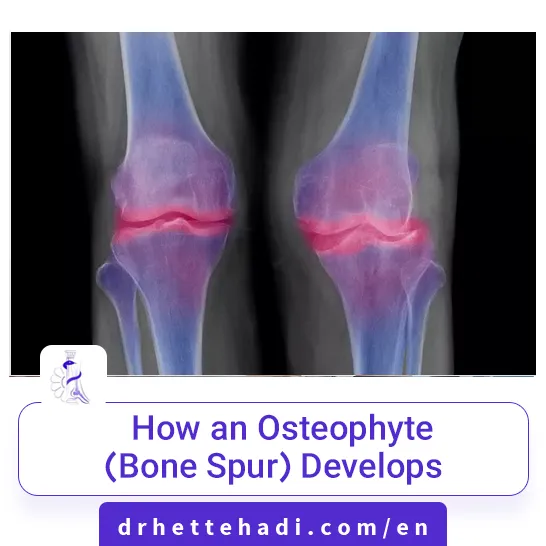An osteophyte is a bony outgrowth, also called a bone spur. It develops slowly over time in and around joints and often causes no symptoms. Osteophytes really only cause pain if they impinge on other structures (such as muscles or nerves) or grow so large as to restrict the movement of a joint.
This article looks at the causes and symptoms of osteophytes as well as how bone spurs are diagnosed and treated.
Also Known As
Osteochondral nodules
Osteochondrophytes
Chondro-osteophytes
What Causes Osteophytes?
Osteophytes typically develop in joints that are degenerating. They are associated with the most common form of arthritis called osteoarthritis (also known as “wear-and-tear arthritis”).1
With osteoarthritis, the progressive loss of cartilage between joints exposes the underlying bone, called subchondral bone. This affects the normal process of bone remodeling during which bone is continually broken down and rebuilt to keep it strong.1
When cartilage is lost, the remodeling will be altered in an attempt to repair the damaged joint and keep it stable. It is an erratic and haphazard process that can lead to the formation of bony outgrowths called osteophytes.2
Exactly how osteophytes form and what stimulates their formation is not completely understood. Osteophytes tend to develop in areas of cartilage loss but can also sometimes occur in the absence of any cartilage damage.2
Osteoarthritis (Degenerative Arthritis): Symptoms and Treatment
Risk Factors
In addition to osteoarthritis, there are other factors and conditions that contribute to the risk of osteophytes, including:3
Older age
Disc degeneration
Tendonitis (tendon inflammation)
Sports injury or other joint injuries
Poor posture
Family history
Congenital bone conditions (such as osteochondroma)
Symptoms of Osteophyte
An osteophyte itself is not painful, but its effect on adjoining structures can cause pain and other symptoms. There are several types of osteophytes that vary by their location and the symptoms they cause.3
These include:
Marginal osteophytes: These develop at the edges of any joint. These often cause no pain or symptoms.3
Central osteophytes: These develop within the joint space of the hip, knee, shoulder, and other freely moving joints (called diarthrodial joints). These can “catch” as you move the joint and cause pain as the spur rubs against muscle or nerves.3
Cervical osteophytes: These develop on any of the seven vertebrae (spinal bones) of the cervical spine of the neck. They cause nerve impingement (pinched nerves) that leads to radiating pain or numbness in the neck and arm along with weakness of the neck and upper extremities.4
Thoracic osteophytes: These develop on any of the 12 vertebrae of the thoracic spine of the upper and middle back. Nerve impingement here can cause radiating pain or numbness in the neck, shoulders, back, or chest as well as muscle spasms and the inability to flex or bend the torso.4
Lumbar osteophytes> These develop on any of the five vertebrae in the lumbar spine of the lower back. Nerve impingement here can cause radiating pain to the arm, buttocks, or down into the legs (sciatica) along with numbness, burning, cramping, or weakness in the arms, hands, or legs. 4
Diagnosis
Osteophytes are diagnosed based on a review of your medical history, a physical exam (evaluating joint mobility and pain), and imaging studies.
Osteophytes generally cannot be seen. The exception is an osteophyte of the hand that can cause a visible bump on a proximal interphalangeal (PIP) joint just above the knuckle, a distal interphalangeal (DIP) joint near the end of a finger, or first carpometacarpal (CMC) joint at the base of the thumb.5
For other joints, an osteophyte is confirmed using imaging studies, such as:3
X-ray: A plain film image involving low-dose radiation
Computed tomography (CT): A composite of multiple X-ray images
Magnetic resonance imaging (MRI): An imaging technique involving powerful magnetic and radio waves that is good at imaging soft tissues such as cartilage
If X-rays were performed on everyone over 50 years of age, most would show some evidence of osteophyte formation. Even so, most osteophytes don’t produce any symptoms.3
Treatment of Osteophytes
The presence of an osteophyte alone is not clinically significant unless it causes symptoms. Of people who develop symptoms, approximately 40% require treatment.2
Treatment options include:3
Over-the-counter analgesics (painkillers): Such as Tylenol (acetaminophen)
Nonsteroidal anti-inflammatory drugs (NSAIDs): Including over-the-counter NSAIDs like Advil (ibuprofen) and prescription NSAIDs like Celebrex (celecoxib)
Physical therapy: Used to maintain joint flexibility and range of motion
Steroid injections: Delivered into a joint space to provide longer-term relief from inflammation
Osteophytectomy: The surgical removal of a bone spur
Laminectomy: A surgery that widens the spinal canal to relieve nerve impingement
Surgery is reserved for people who have not responded to conservative treatment and have severe restriction of mobility and/or a loss of quality of life.
Summary
Osteophytes are bone spurs commonly associated with osteoarthritis. Osteophytes are caused by the progressive loss of cartilage that trigger the abnormal remodeling of bones. Bone spurs can develop in any joint of the body but are more likely to cause symptoms in the spine or in movable joints like the hips, knees, shoulders, or fingers.
Imaging tests can confirm the diagnosis of osteophytes. The treatment may involve painkillers, physical therapy, steroid injections, and surgery.
FREQUENTLY ASKED QUESTIONS
Can an osteophyte cause breathing problems?Yes, In severe cases, cervical osteophytes of the neck can cause obstructive sleep apnea, vocal fold paralysis, and food aspiration (when food enters the airway instead of the esophagus).4
How are bone spurs in the knees treated?There are several treatments for bone spurs found in the knees. This includes cortisone injections, over-the-counter pain relief medications, physical therapy, and knee arthroscopy, a type of surgery that removes bone spurs in the knee.Learn More: What Is a Bone Spur in the Knee?

